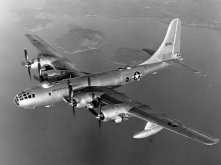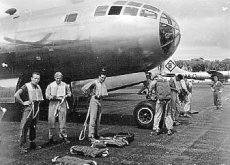
B-29 Superfortress
The B-29 was the first pressurised bomber to enter service, and was therefore able to operate over vast distances and at safe heights to deliver huge bombloads onto the enemy.
Originally designed to bomb Germany from America during World War II, the B-29 entered service only at the end of the European war. This massive, revolutionary bomber was transferred to the fight against Japan, where it devastated cities in huge firebomb raids.
Without the reach of the B-29, America would have had to fight for much longer to recover the Pacific islands from Japan. And it was the B-29 that delivered the final, catastrophic blow in the form of two atomic bombs, dropped onto the cities of Hiroshima and Nagasaki.
Post-war, the B-29 joined the Royal Air Force as the Washington, and inspired the Russian Tu-4. Its final battle was in Korea, where it carried out night bombing raids and shot down many enemy aircraft.
Boeing's talent for turning out huge aircraft paid a super divident with the Superfortress: the B-29 became the 'big stick' of the final campaign of World War II. Feared by those who fell beneath its shadow, this giant brought war home to Japan's cities and people and ushered in the atomic age. The B-29 also fought in Korea, it was converted into a key post-war transport and tanker, and was even copied without permission by the Russians.
 |
 |
 |
| In RAF service the B-29 Superfortress served as a nuclear bomber, and as a secret reconnaisance aircraft which probed Soviet airspace for electronic signals. |
In Korea, B-29 gunners were so good at shooting down enemy aircraft that it became the second highest scoring Allied type. |
In its KB-29 form the Superfortress was the world's first true service tanker aircraft, pionering the inflight refuelling that has become vital to modern air combat. |
|
B-29 Superfortress (Technical Specification) |
| Role |
Ten or eleven long range strategic bomber |
| Manufacturer |
Boeing |
| Maximum Speed |
576 kmh (358 mph) |
| Maximum Range |
5,230 km (3,250 miles) |
Weight
Empty
Loaded weight |
31,815 kg (70,140 lbs)
56,245 kg (123,999 lbs) |
Dimensions
Wingspan
Length
Height
Wing Area |
43.05 meters (141 ft 3 in)
30.18 meters (99 ft 2 in)
9.02 meters (29 ft 7 in)
161.27 square meters (1,736 sq ft) |
| Engines |
Four Wright R-3350 Cyclone 18 turbocharged radial piston each providing 1,641-kW (2,200 hp) |
| Armament |
Two 12.7 mm (0.50 cal) machine guns in each of four remotely-controlled turrets
Two or three 12.7 mm guns
One 20 mm cannon in the tail; bombload 9,072 kg (20,000 lb)
|
Photo Gallery
Click here to submit your photo
| Have A Passion For Aircraft? |
Subscribe to our 14 series FREE newsletter
delivered weekly on World War 2 Aircraft factfile... |
| NB:- We hate spam as much as you do, so your email address will NEVER be shared with or sold to anyone else. That's a Guarantee. |
|
|





